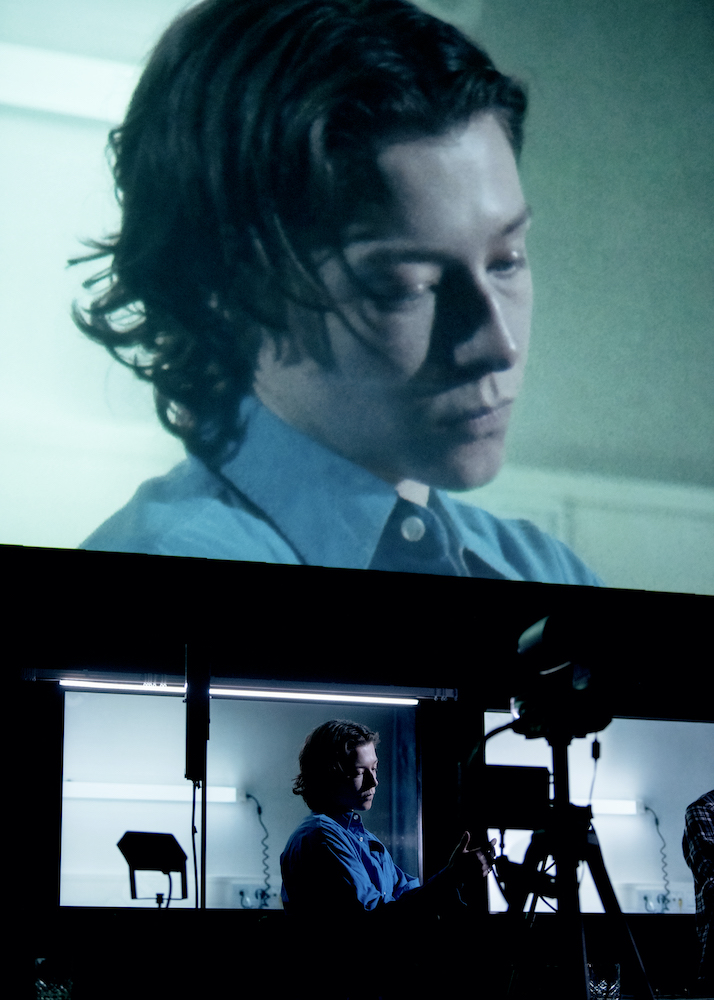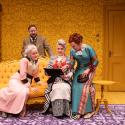When does creativity become mannered? When it’s based on repetition, and repetition without development. About halfway through star director Katie Mitchell’s staging of Margaret Perry’s adaptation of Maggie Nelson’s Bluets – despite the casting of the always watchable Ben Whishaw – I had the horrible feeling that this 80-minute show was on repeat. Moody words, repeat, moody visuals, repeat, moody mood, repeat, repeat, repeat.
Which is very sad because Bluets is the first offering from Royal Court’s new artistic director David Byrne, hyped up as, in his words, “the path of maximum adventure”. Unfortunately, it’s neither as adventurous nor as edgy as it claims to be. Okay, so Perry – whose Paradise Now! was one of the most original plays of 2022 – adapts Nelson’s 240 short paragraphs about desire, depression and the colour blue in a coherent monologue which follows the original closely, but it’s also slightly disappointing in the flattened tone of much of the language. I wish she had been bolder. Still, it tells the story: a nameless woman has a male lover who leaves her, preferring another woman with whom he’s also had a relationship; the woman remains both obsessively in love with the man, and also depressed, a state of mind illustrated by her equally obsessive interest in the colour blue.
Mitchell splits the subjective monologue into three voices – Whishaw, Emma D’Arcy and Kayla Meikle. At its best, this gives the performance a fractured, modernistic feel; at its worst, it is distracting and never achieves the emotional intensity of, say, Sarah Kane’s Crave. The beauty of Nelson’s book is its flash thoughts, but here the monologue is less distinctive. It has much less cumulative charm than the book. More than anything the three voices tend to emphasise our distance from the woman’s thoughts, which seems a bit counterintuitive – wouldn’t it be better to be able to empathize rather than be pushed away? But maybe that’s the point: the depressive obstructs any attempt at consolation, or help.
 The most obvious distancing device, and one that Mitchell has made her trademark, is what she calls "Live Cinema", a technique which she has used again and again and again since 2006 when her version of Virginia Woolf’s The Waves was such a stunningly original success. The actors are lined up in a row, each with their own tabletop, in front of three individual screens. Cameras film close-ups of their hands moving objects like whisky glasses or blue marbles, or holding hands for sex or friendship, and also their heads in front of their screens. The result is then put together and projected on a large screen above them (pictured right, with Emma D’Arcy).
The most obvious distancing device, and one that Mitchell has made her trademark, is what she calls "Live Cinema", a technique which she has used again and again and again since 2006 when her version of Virginia Woolf’s The Waves was such a stunningly original success. The actors are lined up in a row, each with their own tabletop, in front of three individual screens. Cameras film close-ups of their hands moving objects like whisky glasses or blue marbles, or holding hands for sex or friendship, and also their heads in front of their screens. The result is then put together and projected on a large screen above them (pictured right, with Emma D’Arcy).
Apart from the fact that this approach is now less experimental than mannered, I have to say that the actual film, which is the main visual presence of the show, is dreary in its banality. The actors are filmed walking down a street, in a café, on the tube, behind the wheel of a car: the pictures are in themselves visually uninspired and uninteresting. What’s needed here is a film-maker with an original visual imagination. Okay, you could argue that the experience of depression is one in which the world is bleached out, and everything seems drearily banal – but then this literal representation of this mental state seems even more unimaginative, and does Nelson’s often poetic book no favours.
What’s missing in Mitchell’s Bluets – which she originally staged in Hamburg in 2019 (see what I mean about repetition?) – is, ironically enough, a love of the colour blue. Every image projected on the big screen is light-blue, grey-blue or washed-out blue. The text might mention turquoise, or allude to those blues such as indigo or ultramarine or Klein blue, but we never see these. Instead, we get hospital corridor blues – perhaps a deliberate illustration of those passages in which the woman visits her friend who has been hospitalised after a serious accident. But the lack of colour, the dark clothes worn by the cast, is not so much a representation of depression as depressing to watch.
Nelson writes beautifully about obsessive love, and Perry alludes in the programme to the way a book “provides company for its readers”, reminding me of how – to choose some random examples from my own subjective experience – books such as Sigrid Nunez’s The Friend, Roland Barthes A Lover’s Discourse, or William Hazlitt’s Liber Amoris help make sense of any love and loss that might take over your head. But neither in its text, nor in its staging, does this play really explore the emotion of depression, its paralyzing devastation, its destruction of reasoning, its blackness. Instead, we get a rather plain aesthetic account, less subjective than arty.
During the show, Perry – following Nelson – not only mentions a wonderful list of objects, things and places that are coloured blue, from tiles to marbles, from skies to pigments, from rocks to shards of glass, but also quotes from a wide variety of European and American artists and intellectuals, from Johann Wolfgang von Goethe to Ludwig Wittgenstein to Derek Jarman to Joni Mitchell to Joseph Cornell: blue paintings, songs of blue, films of blue. Although these mentions are rarely visualised they do convey a sense of beauty, and one striking visual image – the full moon (blue moon?) superimposed over an eye – does illustrate what can be done.
The other thing that’s missing from the show, at least for me, is a sense of drama. In Nelson’s original, the layout of the short numbered paragraphs gives a feeling of momentum, of an active search for truth in its comparison of personal experience and quotations from literary sources. It gives you the gift of time to study these juxtapositions. To think, for example, about the local American references and the many mentions of the divine. On stage, as a three-voice monologue, the effect is dense and difficult to follow, and I don’t get the sense of either of a search or of a meditation.
Occasional wry jokes, about six-hour sex sessions, and observations of the way pain can bring people together in a visceral shared understanding offer some compensation for an evening that is more a monotone than a vibrant colourful experience. Sadly a beautiful cast – playing A, B and C – spend most of their energy changing costumes and arranging props, rather than, you know, actually acting, but that matches the depressed vibe of the piece. As well as Mitchell, I should mention designer Alex Eales, video director and designer Grant Gee and Ellie Thompson, who all contribute to the overall effect. If you’ve never seen a Katie Mitchell show, this is a great chance to experience her manner of work. I only wish that she could develop it further, better, wilder, more colourfully and more visually.














Add comment